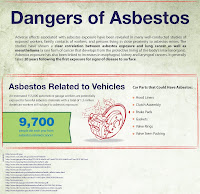Although your car can feel like a sanctuary in heavy traffic or stormy weather, the inside of a vehicle can actually be hazardous to your health. Today's modern cars and trucks are made from a variety of synthetic materials that can release poisonous substances into the air. Sometimes these substances are formed over time, with exposure to heat and sunlight, but some of them come with a brand new car. That “new car smell” that distinguishes a vehicle fresh off the dealer's lot is actually caused by harmful substances.
Take a look inside your car and you'll find synthetic carpeting and upholstery, plastic consoles and instrument panels, soft vinyl armrests and molded plastics. Car manufacturers use a variety of flame-retardants inside vehicles to help improve passenger safety in an accident. Various substances are used to make the plastics soft, flexible, and resistant to impact. Fabrics are often treated with arsenic during the manufacturing process, and a leather interior has usually been tanned with chromium. Chlorine and lead are often found in the plastic parts. Under the hood can lurk dangers like asbestos, and none of these substances are safe to inhale.
The list of problems caused by these toxic substances is even longer than the list of poisons, a major concern since many people spend hours a day in their vehicles. Birth defects, liver toxicity, learning disabilities, premature birth, and hormone disruption are all known to be caused by the same toxic substances that give a new car its distinctive smell. As a vehicle ages, these compounds can break down into even more harmful substances. The effects of long term exposure to the substances used in car manufacture have not been adequately studied, but doctors suspect everything from cancer to mesothelioma. 
The toxic substances found in vehicles are most likely to harm the most vulnerable passengers. Even children's car seats have been found to contain substances like bromine, chlorine, and heavy metals. As the interior of the car heats up on a hot day, the air inside the vehicle becomes more and more toxic. Studies have found that air pollution inside vehicles can be significantly worse than air pollution outdoors or inside buildings. Vehicles that are several years old have already released a large amount of their toxic substances and can have somewhat better air quality. Older cars are more likely to have dangers like asbestos lurking under the hood, especially in hood liners, brake pads, clutch assemblies, and gaskets. Those who drive or maintain these vehicles should take precautions to reduce their risk of exposure.
Latest Auto News
Popular Auto News
-
Paul A. Eisenstein, the Detroit Bureau 11 clock. It was the star of the hometown car show now motor hopes General but to prove that his ne...
-
Paul A. Eisenstein, NBC News contribution "This is one of the few places where one can see a Chevrolet Volt jam," laughs Scott Hi...
-
J. Scott Applewhite / AP "Key questions about the cause of the unintended acceleration remain unanswered" Senator Charles Grass...
-
Sale of vehicles, to be able, even driving in about two decades, published according to a forecast by IHS automotive car industry consultant...
-
A 2010 edition of Toyota's Corolla, the best-selling vehicle of all time. By 24/7 Wall St., Douglas A. McIntyre The most successful car ...
-
Although the number of deaths due to vehicle is strongly decreased collisions over the last 10 years, deaths in accidents with pedestrians a...
Auto News Tags
- America (8)
- Americans (9)
- Auto News (5)
- Cadillac (12)
- Chevy (26)
- China (17)
- Chrysler (59)
- Detroit (20)
- Focus (8)
- Ford (13)
- Future (11)
- GM (24)
- Honda (44)
- Hyundai (9)
- Lexus (11)
- Mercedes (15)
- Nissan (20)
- Recalling (13)
- States (17)
- Study (12)
- Tesla (20)
- Toyota (75)
- United (11)
- Volkswagen (10)
- about (8)
- after (10)
- again (14)
- automakers (26)
- autos (9)
- bankruptcy (8)
- battery (12)
- buyers (10)
- contract (7)
- crash (10)
- dealer (8)
- dealers (9)
- drive (7)
- driver (7)
- drivers (12)
- driving (8)
- economy (10)
- electric (25)
- green (9)
- hybrid (11)
- industry (12)
- luxury (19)
- market (13)
- mileage (9)
- million (31)
- offers (8)
- prices (13)
- problem (16)
- problems (9)
- production (18)
- profit (23)
- recall (19)
- recalls (55)
- sales (61)
- small (17)
- truck (13)
- vehicle (8)
- vehicles (28)
- worst (8)
- years (12)
Auto News Archive
Copyright © 2019 Auto News






0 коммент.:
Post a Comment